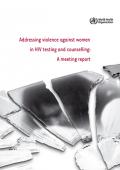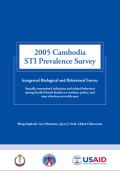What's New
Displaying results 4551 - 4560 of 4914

Resource | Publications,
Although the prevalence of HIV and AIDS is still below 0,1 percent among general population, number of new HIV cases is increasing year by year. It is even more alarming the fact that some of the cases are from the general population, not most-at-risk ones.
For Mongolia which has been a somewhat closed country until beginning of 1990, the epidemic of HIV has started relatively later.

Resource | Publications,
The government of Lao People’s Democratic Republic (Lao PDR) has taken action to prevent the epidemic of HIV/AIDS in the country even before the identification of first case of HIV infection in 1990 and the first person with AIDS in 1992 (NCCA established in 1989). Since then, many HIV prevention projects/programmes have been implementing countrywide. Efforts to fight against HIV epidemic, including STI prevention and treatment, behavioural change communication intervention, peer education, life skills training in school, community based interventions, the 100% condom use programme and other measured approaches have been integrated into general development programmes. On the other hand, capacities on management, coordination, monitoring and evaluation, and research (surveillance, KAP survey, BSS) of NCCA staff are improved.

Resource | Publications,
The purpose of this report is to report to UN Secretary General regarding Indonesia’s progress in the fight against AIDS over the period of 2004–2005, by reporting on 9 specific indicators in a manner defined in the UNAIDS Guidelines for the Construction of Core Indicators.

Resource | Publications,
Multisectoral Strategic Plan (2004-2010) exists and a detailed operational plan for scaling up the response up to 2010 is being finalized.

Resource | Publications,
Pakistan at present is categorized as "Low-Prevalence High Risk" country for Human Immunodeficiency Virus (HIV) infection. According to the National AIDS Control Programme/Ministry of Health estimates using WHO/UNAIDS Epiforecast model the number of HIV infected individuals in Pakistan at the end of 2005 are between 70-80, 000 in a total population of 157 million, with a prevalence of 0.1% among general population.

Resource | Publications,
Fiji recorded their first four cases of HIV in 1989, three being males and one being female. In the ten-year period between 1989 and 1998, Fiji had a total of 46 people diagnosed with HIV infections, an average of approximately 5 persons per year. In the five-year period between 1999 and 2003, a total of 96 new cases have been diagnosed with HIV, with the two highest figures being 26 in 2002 and 31 in 2003.

Resource | Publications,
By October 31, 2005, the cumulative number of HIV cases reported nationwide was 102,391 cases, of which as many as 16,917 cases were AIDS patients, and 9,862 death cases caused by AIDS. During the first 10 months of 2005 alone, as many as 12,011 HIV newly infected cases were reported nationwide, of which 2,489 AIDS patients and 1,464 deaths were reported.

Resource | Publications,
This report is based on a consultation organized by the department of Gender, Women and Health (GWH) of the World Health Organization (WHO), in collaboration with the Department of HIV/AIDS (HIV), WHO in Geneva from January 16–18, 2006. The meeting was supported with funds from the Swedish International Development Cooperation Agency (SIDA) and the Canadian International Development Agency (CIDA).

Resource | Laws and Policies,
In order to prevent and control the incidence and prevalence of AIDS, to protect human health and public health, infectious disease law, the enactment of this Ordinance.
AIDS prevention put prevention first and combine prevention policy, the government established organizational leadership, departmental responsibilities and the whole society to participate in the mechanism, strengthen publicity and education to undertake behaviour intervention and rescue measures Implement a comprehensive prevention and treatment.
No unit or individual may discriminate against HIV-infected persons and AIDS patients and their families. HIV-infected persons and AIDS patients and their families in marriage, employment, medical care, schooling and other legitimate rights and interests are protected by law.

Resource | Publications,
The 2005 Sexually Transmitted Infection (STI) Prevalence Survey is the third of its kind in Cambodia.
The objectives of this survey were:
- to estimate the prevalence of gonorrhea, chlamydia, syphilis, and related risk behaviors among three sentinel groups;
- to estimate HIV among men who have sex with men (MSM); and
- to provide data for planning and management of sexually transmitted infection (STI) control and prevention programs.





